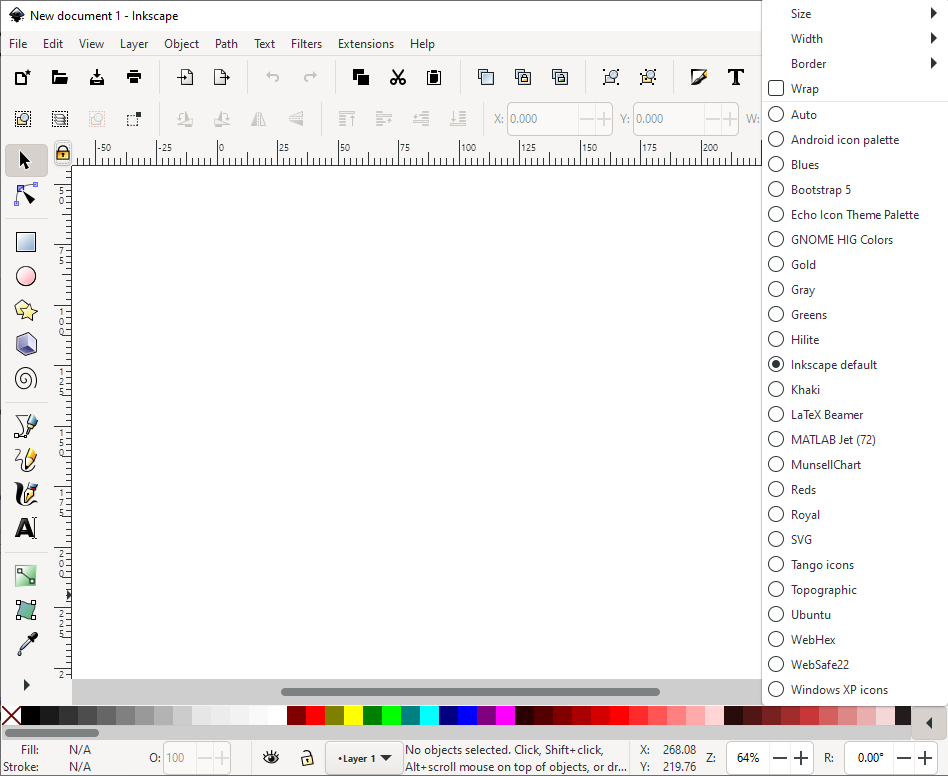

Line+spline as well as line only output modes. Some programs have difficulty reading DXF files with splines (curves), so the Desktop Edition supports The AI format is fairly widely supported, but is less ubiquitous than the EPS format, and most programs that read AI can also read EPS.Ī CAD format from Autodesk, used by CAD tools from many different vendors. The native format of Adobe Illustrator is the AI format (Adobe Illustrator Artwork), a modified version of the older EPS format.
#Inkscape color picker pdf
Support for reading and editing PDF files is much more limited. Those tools work with any program that is able to print. (third party tools that perform the same task are also for sale).

Further information on the SVG format may be found on the official SVG website.Īdobe's PDF format (Portable Document Format) is very widely used as a general purpose platform-independent document format.Īnd while it is not exclusively used as such, it is also a very good vector image format.Īdobe gives away the Acrobat PDF reader, but sells the tools required to create PDF files Inkscape and recent versions of Adobe IllustratorĪnd CorelDRAW have good support for reading and writing SVG. The W3C standard vector image format is called SVG (Scalable Vector Graphics). Ghostview can read it very well but does not have any editing capabilities. Color selector (RGB, HSL, CMYK, color wheel, CMS) Color picker tool Copy/paste style A gradient editor capable of multi-stop gradients Pattern fills (bitmap/vectors) Dashed strokes, with many predefined dash patterns Path markers (ending, middle and/or beginning marks, e.g.
#Inkscape color picker full
It is widely supported as an export format, but due to the complexity of the full format specification, not all programs that claim to support EPS are able to import all variants of it.Īdobe Illustrator and recent versions of CorelDRAW have very good support for reading and writing EPS. It is the standard interchange format in the print industry. In any case, all of the variants of BMP should be avoided when possible, as they use little to noĬompression and consequently have unnecessarily large file sizes.Īdobe's EPS format (Encapsulated PostScript) is perhaps the most common vector image format. Most modern image editing tools are able to read both. Own formats, both of which are called BMP. There are actually several BMP formats (BitMaP). Vector Magic recommends using the PNG format when storing logos as bitmaps. This format is widely supported by web browsers and image viewers/editors. The best of the lossless image formats is called PNG (Portable Network Graphics). They are more suitable for things like logos. These store an exact pixel-by-pixel representation of the image, but require more space. We do not recommend using JPEG files for rasterized vector art, as the compression artifacts substantially degrade the quality of the image near edges. It has excellent compression characteristics and has the nice feature that the user may specify what level of compression they desire, trading off fidelity for file size. One of the most widely-used image formats. They are also commonly used on the web to save bandwidth. They are best suited to photographs and other images where perfect accuracy is not important.

These have smaller file sizes but do not store a perfect copy of the image. Some of the most common are: JPEG, PNG, GIF, BMP, and TIFF.īroadly speaking, they fall into two categories: Lossy formats I'll read Tavmjong's overview of filter creation at a later time in more detail.There is a large number of different bitmap formats. What should I add to this filter in order to change the stroke as well? Any good references for creating filters?Įdit: Connecting Input 1 (i1) to "Fill Paint" and Input 2 (i2) to "Stroke Paint" doesn't seem to work. However, this only changes the fill, not the stroke. The 1.4 factor seems a little too much, but 1.2 is about right. To be honest, I don't have any experience creating filters. In the topic you linked there seems to be some confusion about the application (whether the graphic is bitmap/raster or vector), but the linked request on launchpad sounds more or less like the functionality I'm looking for.Īddition: Thanks v1nce for your input. If I would have a little more time, I'd just write a script to fix the problem, but this seems like a pretty standard thing (so it's either already available in Inkscape or on a wishlist). But unfortunately, they (the sliders) are not there when the objects have different styles. By simplifying my question I completely forgot about the HSL sliders. Actually, there are multiple vector objects that I'd like to change at once. Hi Druban, thanks for your answer and the compliment.


 0 kommentar(er)
0 kommentar(er)
